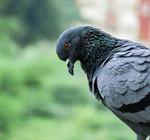
28 Jul 2025 | Apex Environmental Services (UK) Ltd
How to Get Birds Out of Attic
The quiet fluttering above the ceiling? It’s not your imagination. Once birds find a way into your attic, they won’t leave on their own. The warmth, safety, and nesting potential keep them there - often for months. And while it might start with the occasional rustle, infestations can escalate fast.
Not only is the noise disruptive, but bird droppings, parasites, and feather debris create serious hygiene risks. Structural damage is another concern: insulation gets shredded, vents get blocked, and acidic droppings corrode surfaces over time. Getting them out isn’t just a chore - it’s a necessity.
So how exactly do you do it?
Step One: Confirm What You’re Dealing With
You need certainty before action. That means identifying what kind of bird is in your attic - because different species require different approaches.
Listen for patterns. Pigeons tend to move in groups and make low cooing sounds. Starlings chirp more frantically. Sparrows? Lighter scratching, rapid flapping, often at dawn and dusk. If you’re hearing activity throughout the day, you’re likely dealing with a larger number.
And don’t just go by sound. Look for droppings, feathers, and entry holes around eaves or vents. Nesting materials near insulation are another giveaway. If you notice any of these, it’s worth reviewing the clear signs your home is infested with birds to assess how advanced the problem is.
Step Two: Don’t Try To Trap Them
It’s tempting to handle things solo. A broom, a torch, maybe a bit of courage. But that backfires - quickly.
Trapping birds without proper licensing is illegal in many areas, and frankly, ineffective. Panicked birds damage themselves and your property, often fleeing deeper into recesses or injuring themselves trying to escape. Worse still, disturbing nests during breeding season may lead to orphaned chicks or legal trouble.
We’re not just talking ethics - it’s about what actually works.
Step Three: Locate And Seal All Entry Points
This part takes patience. Birds almost always return to familiar roosts, so even if you manage to shoo them out temporarily, they’ll find their way back in unless every gap is sealed.
Start with the roofline. Check soffits, vents, chimney openings, and any rotted fascia boards. The holes they use may be surprisingly small - some birds squeeze through gaps the width of a credit card.
Professional exclusion methods involve more than a casual patch-up. One of the most effective solutions? Installing mesh protection against unwanted birds around high-risk access points. This kind of netting creates a barrier that prevents entry while still allowing your attic to ventilate properly.
Step Four: Use One-Way Exits - Not Poison
Once you’ve found the entry points, don’t just block them. That risks trapping birds inside, causing distress and potentially leading to carcasses rotting in your roofspace.
Instead, install a one-way bird exclusion device. These mechanisms let birds exit - but not re-enter. They’re particularly effective for small infestations where birds haven’t built nests yet. Give it a few days, monitor the activity, and once it’s silent, you can seal things up for good.
Never, under any circumstances, use poison. Not only is it illegal for most bird species, but it also causes immense suffering and secondary infestations - from insects to rodents that feed on dead birds.
Step Five: Decontaminate The Area

Even after the birds are gone, their presence lingers - literally.
Droppings carry diseases like histoplasmosis and salmonella, and the fine dust from dried droppings can become airborne. Nesting material often contains mites and ticks. You’ll want to wear protective gear and use strong disinfectants to clean insulation, beams, and flooring.
In severe cases, this step alone justifies bringing in professionals. It’s not overkill - it’s risk management.
When DIY Isn’t Enough
Some infestations are stubborn. Maybe the birds have nested, or maybe you’ve sealed everything and they’re still getting in. If that’s the case, it’s time to call in experts who can conduct a full inspection, recommend deterrents, and handle removal in compliance with UK wildlife laws.
Specialists also offer long-term solutions like roofline reinforcement, acoustic deterrents, or falconry control in commercial settings. It’s not always cheap - but neither is long-term property damage.
Closing Thoughts
Getting birds out of your attic isn’t just about peace and quiet. It’s about hygiene, safety, and protecting your home’s structure. From correct identification to sealing and cleaning, each step matters - and skipping one often means starting over.
The sooner you act, the simpler the fix. Let it drag, and you risk turning a minor issue into a costly restoration project.
And once the birds are out? Keep them out. That’s where prevention - not reaction - makes the real difference.


